Abstract
The proteins P1, P2, and P4 of the glycine cleavage system have been purified from the anaerobic, glycine-utilizing bacterium Eubacterium acidaminophilum. By gel filtration, these proteins were determined to have Mrs of 225,000, 15,500, and 49,000, respectively. By sodium dodecyl sulfate-polyacrylamide gel electrophoresis, protein P1 was determined to have two subunits with Mrs of 59,500 and 54,100, indicating an alpha 2 beta 2 tetramer, whereas the proteins P2 and P4 showed only single bands with estimated Mrs of 15,500 and 42,000, respectively. In reconstitution assays, proteins P1, P2, P4 and the previously reported lipoamide dehydrogenase (P3) had to be present to achieve glycine decarboxylase or synthase activity. All four glycine decarboxylase proteins exhibited highest activities when NADP+ was used as the electron acceptor or when NADPH was used as the electron donor in the glycine synthase reaction. The oxidation of glycine depended on the presence of tetrahydrofolate, dithioerythreitol, NAD(P)+, and pyridoxal phosphate. The latter was loosely bound to the purified protein P1, which was able to catalyze the glycine-bicarbonate exchange reaction only in combination with protein P2. Protein P2 could not be replaced by lipoic acid or lipoamide, although lipoic acid was determined to be a constituent (0.66 mol/mol of protein) of protein P2. Glycine synthase activity of the four isolated proteins and in crude extracts was low and reached only 12% of glycine decarboxylase activity. Antibodies raised against P1 and P2 showed cross-reactivity with crude extracts of Clostridium cylindrosporum.
Full text
PDF
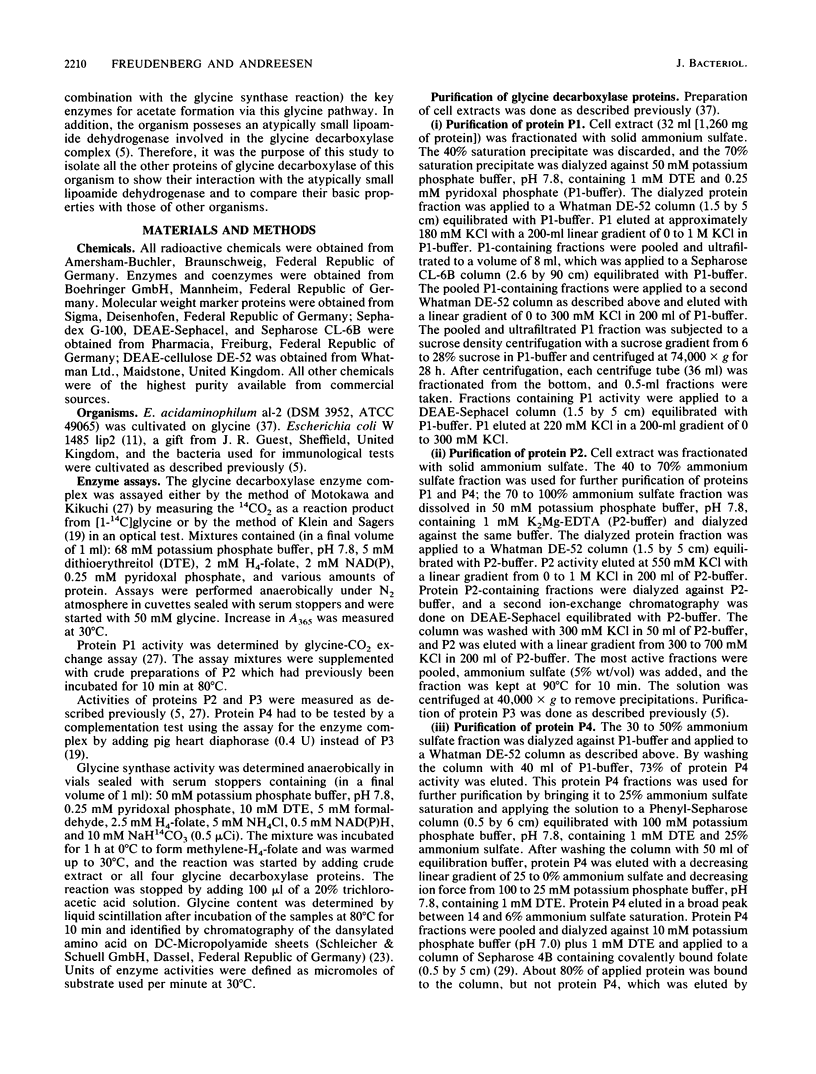
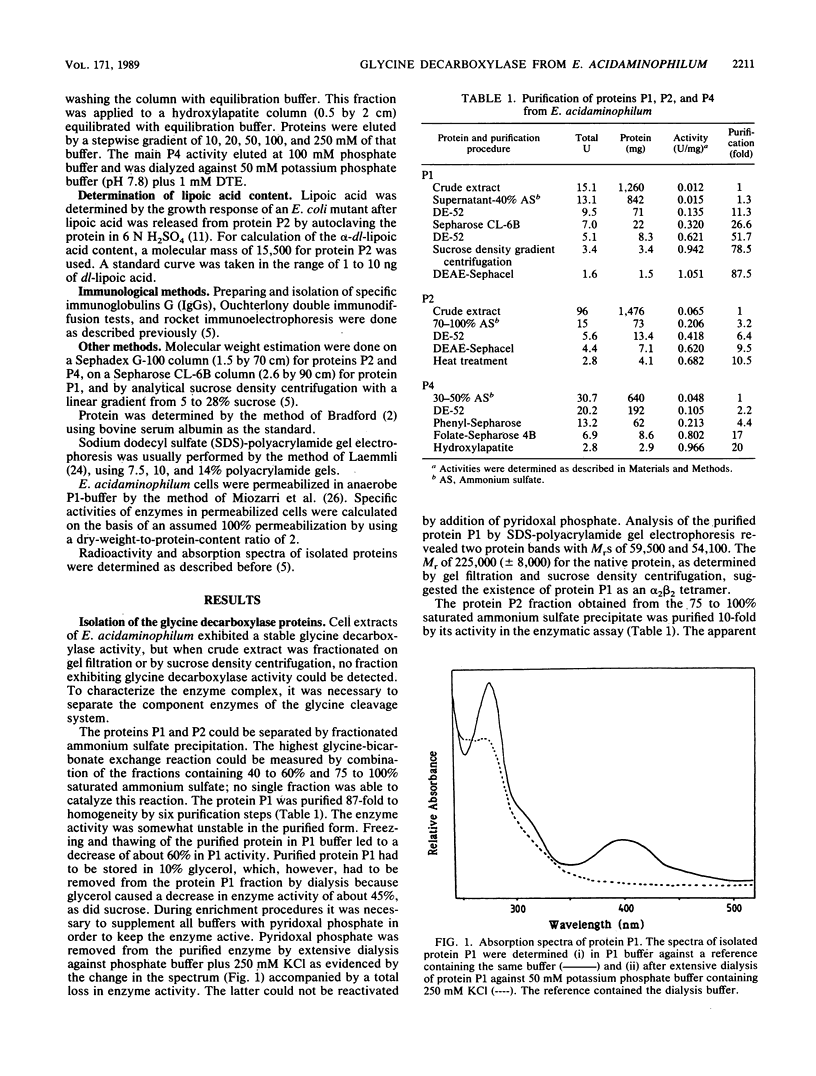
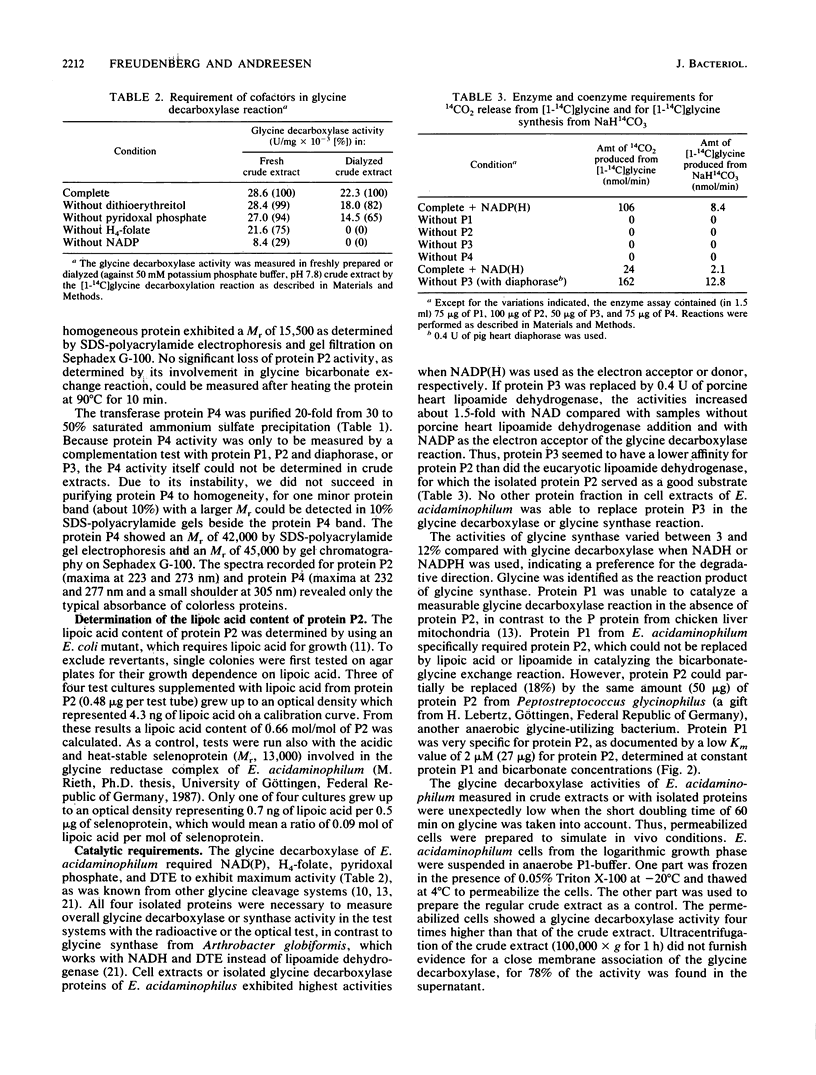

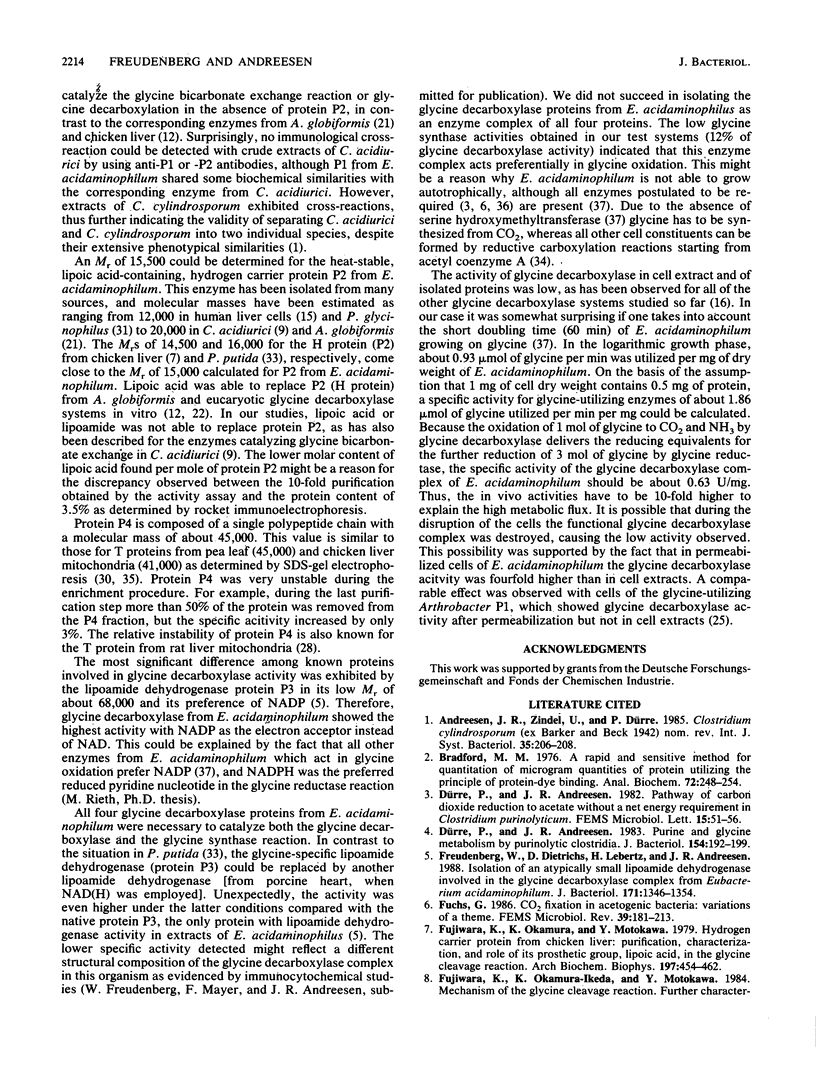
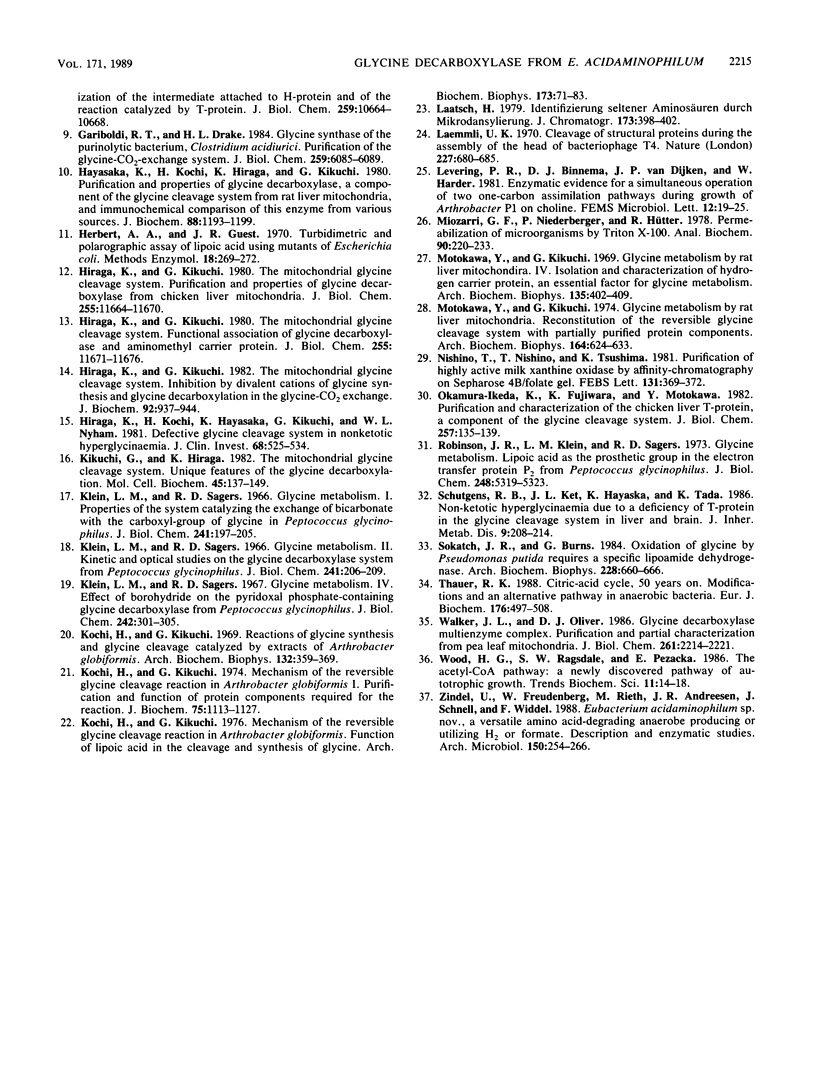
Selected References
These references are in PubMed. This may not be the complete list of references from this article.
- Bradford M. M. A rapid and sensitive method for the quantitation of microgram quantities of protein utilizing the principle of protein-dye binding. Anal Biochem. 1976 May 7;72:248–254. doi: 10.1006/abio.1976.9999. [DOI] [PubMed] [Google Scholar]
- Dürre P., Andreesen J. R. Purine and glycine metabolism by purinolytic clostridia. J Bacteriol. 1983 Apr;154(1):192–199. doi: 10.1128/jb.154.1.192-199.1983. [DOI] [PMC free article] [PubMed] [Google Scholar]
- Freudenberg W., Dietrichs D., Lebertz H., Andreesen J. R. Isolation of an atypically small lipoamide dehydrogenase involved in the glycine decarboxylase complex from Eubacterium acidaminophilum. J Bacteriol. 1989 Mar;171(3):1346–1354. doi: 10.1128/jb.171.3.1346-1354.1989. [DOI] [PMC free article] [PubMed] [Google Scholar]
- Fujiwara K., Okamura-Ikeda K., Motokawa Y. Mechanism of the glycine cleavage reaction. Further characterization of the intermediate attached to H-protein and of the reaction catalyzed by T-protein. J Biol Chem. 1984 Sep 10;259(17):10664–10668. [PubMed] [Google Scholar]
- Fujiwara K., Okamura K., Motokawa Y. Hydrogen carrier protein from chicken liver: purification, characterization, and role of its prosthetic group, lipolic acid, in the glycine cleavage reaction. Arch Biochem Biophys. 1979 Oct 15;197(2):454–462. doi: 10.1016/0003-9861(79)90267-4. [DOI] [PubMed] [Google Scholar]
- Gariboldi R. T., Drake H. L. Glycine synthase of the purinolytic bacterium, Clostridium acidiurici. Purification of the glycine-CO2 exchange system. J Biol Chem. 1984 May 25;259(10):6085–6089. [PubMed] [Google Scholar]
- Hayasaka K., Kochi H., Hiraga K., Kikuchi G. Purification and properties of glycine decarboxylase, a component of the glycine cleavage system, from rat liver mitochondria and immunochemical comparison of this enzyme from various sources. J Biochem. 1980 Oct;88(4):1193–1199. doi: 10.1093/oxfordjournals.jbchem.a133074. [DOI] [PubMed] [Google Scholar]
- Hiraga K., Kikuchi G. The mitochondrial glycine cleavage system. Functional association of glycine decarboxylase and aminomethyl carrier protein. J Biol Chem. 1980 Dec 25;255(24):11671–11676. [PubMed] [Google Scholar]
- Hiraga K., Kikuchi G. The mitochondrial glycine cleavage system. Purification and properties of glycine decarboxylase from chicken liver mitochondria. J Biol Chem. 1980 Dec 25;255(24):11664–11670. [PubMed] [Google Scholar]
- Hiraga K., Kikuchi G. The mitochondrial glycine cleavage system: differential inhibition by divalent cations of glycine synthesis and glycine decarboxylation in the glycine-CO2 exchange. J Biochem. 1982 Sep;92(3):937–944. doi: 10.1093/oxfordjournals.jbchem.a134009. [DOI] [PubMed] [Google Scholar]
- Hiraga K., Kochi H., Hayasaka K., Kikuchi G., Nyhan W. L. Defective glycine cleavage system in nonketotic hyperglycinemia. Occurrence of a less active glycine decarboxylase and an abnormal aminomethyl carrier protein. J Clin Invest. 1981 Aug;68(2):525–534. doi: 10.1172/JCI110284. [DOI] [PMC free article] [PubMed] [Google Scholar]
- Kikuchi G., Hiraga K. The mitochondrial glycine cleavage system. Unique features of the glycine decarboxylation. Mol Cell Biochem. 1982 Jun 25;45(3):137–149. doi: 10.1007/BF00230082. [DOI] [PubMed] [Google Scholar]
- Klein S. M., Sagers R. D. Glycine metabolism. I. Properties of the system catalyzing the exchange of bicarbonate with the carboxyl group of glycine in Peptococcus glycinophilus. J Biol Chem. 1966 Jan 10;241(1):197–205. [PubMed] [Google Scholar]
- Klein S. M., Sagers R. D. Glycine metabolism. II. Kinetic and optical studies on the glycine decarboxylase system from Peptococcus glycinophilus. J Biol Chem. 1966 Jan 10;241(1):206–209. [PubMed] [Google Scholar]
- Klein S. M., Sagers R. D. Glycine metabolism. IV. Effect of borohydride reduction on the pyridoxal phosphate-containing glycine decarboxylase from Peptococcus glycinophilus. J Biol Chem. 1967 Jan 25;242(2):301–305. [PubMed] [Google Scholar]
- Kochi H., Kikuchi G. Mechanism of reversible glycine cleavage reaction in Arthrobacter globiformis. Function of lipoic acid in the cleavage and synthesis of blycine. Arch Biochem Biophys. 1976 Mar;173(1):71–81. doi: 10.1016/0003-9861(76)90236-8. [DOI] [PubMed] [Google Scholar]
- Kochi H., Kikuchi G. Mechanism of the reversible glycine cleavage reaction in Arthrobacter globiformis. I. Purification and function of protein components required for the reaction. J Biochem. 1974 May;75(5):1113–1127. doi: 10.1093/oxfordjournals.jbchem.a130483. [DOI] [PubMed] [Google Scholar]
- Kochi H., Kikuchi G. Reactions of glycine synthesis and glycine cleavage catalyzed by extracts of Arthrobacter globiformis grown on glycine. Arch Biochem Biophys. 1969 Jul;132(2):359–369. doi: 10.1016/0003-9861(69)90377-4. [DOI] [PubMed] [Google Scholar]
- Laemmli U. K. Cleavage of structural proteins during the assembly of the head of bacteriophage T4. Nature. 1970 Aug 15;227(5259):680–685. doi: 10.1038/227680a0. [DOI] [PubMed] [Google Scholar]
- Miozzari G. F., Niederberger P., Hütter R. Permeabilization of microorganisms by Triton X-100. Anal Biochem. 1978 Oct 1;90(1):220–233. doi: 10.1016/0003-2697(78)90026-x. [DOI] [PubMed] [Google Scholar]
- Motokawa Y., Kikuchi G. Glycine metabolism by rat liver mitochondria. IV. Isolation and characterization of hydrogen carrier protein, an essential factor for glycine metabolism. Arch Biochem Biophys. 1969 Dec;135(1):402–409. doi: 10.1016/0003-9861(69)90556-6. [DOI] [PubMed] [Google Scholar]
- Motokawa Y., Kikuchi G. Glycine metabolism by rat liver mitochondria. Reconstruction of the reversible glycine cleavage system with partially purified protein components. Arch Biochem Biophys. 1974 Oct;164(2):624–633. doi: 10.1016/0003-9861(74)90074-5. [DOI] [PubMed] [Google Scholar]
- Nishino T., Nishino T., Tsushima K. Purification of highly active milk xanthine oxidase by affinity chromatography on Sepharose 4B/folate gel. FEBS Lett. 1981 Aug 31;131(2):369–372. doi: 10.1016/0014-5793(81)80406-1. [DOI] [PubMed] [Google Scholar]
- Okamura-Ikeda K., Fujiwara K., Motokawa Y. Purification and characterization of chicken liver T-protein, a component of the glycine cleavage system. J Biol Chem. 1982 Jan 10;257(1):135–139. [PubMed] [Google Scholar]
- Robinson J. R., Klein S. M., Sagers R. D. Glycine metabolism. Lipoic acid as the prosthetic group in the electron transfer protein P2 from Peptococcus glycinophilus. J Biol Chem. 1973 Aug 10;248(15):5319–5323. [PubMed] [Google Scholar]
- Schutgens R. B., Ket J. L., Hayasaka K., Tada K. Non-ketotic hyperglycinaemia due to a deficiency of T-protein in the glycine cleavage system in liver and brain. J Inherit Metab Dis. 1986;9(2):208–214. doi: 10.1007/BF01799462. [DOI] [PubMed] [Google Scholar]
- Sokatch J. R., Burns G. Oxidation of glycine by Pseudomonas putida requires a specific lipoamide dehydrogenase. Arch Biochem Biophys. 1984 Feb 1;228(2):660–666. doi: 10.1016/0003-9861(84)90036-5. [DOI] [PubMed] [Google Scholar]
- Thauer R. K. Citric-acid cycle, 50 years on. Modifications and an alternative pathway in anaerobic bacteria. Eur J Biochem. 1988 Oct 1;176(3):497–508. doi: 10.1111/j.1432-1033.1988.tb14307.x. [DOI] [PubMed] [Google Scholar]
- Walker J. L., Oliver D. J. Glycine decarboxylase multienzyme complex. Purification and partial characterization from pea leaf mitochondria. J Biol Chem. 1986 Feb 15;261(5):2214–2221. [PubMed] [Google Scholar]


